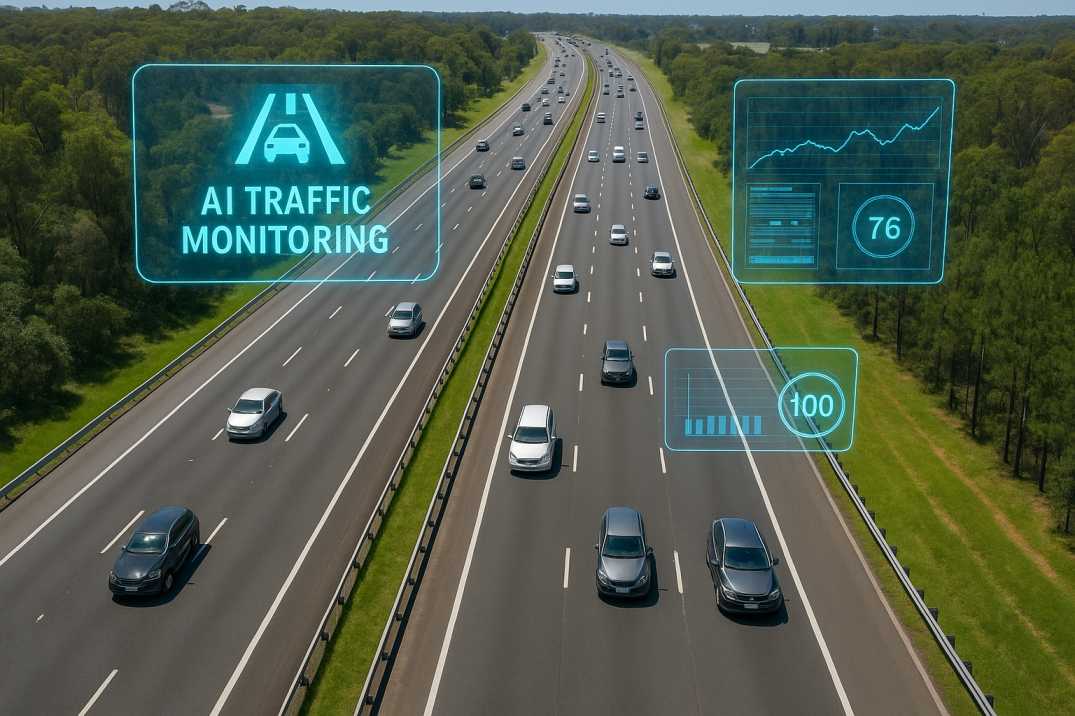Contact Us
RoadVision AI
Private Limited
Office No. 308 & 310, B Block
Ansal Chamber - 1, Bhikaji Cama Place,
Near Engineers India Limited (EIL) Bhawan, New Delhi - 110066
© 2024 | RoadVision AI | All rights reserved
The road networks of Australia are undergoing a significant transformation with the rise of smart highways in New South Wales. Increasing traffic demand, urban population growth, and stringent safety regulations have pushed authorities and contractors to adopt innovative solutions. Advanced systems such as AI road asset management and AI-based traffic monitoring are now becoming integral to ensuring smooth traffic flow, reducing congestion, and improving overall transport efficiency.
The state of New South Wales, with Sydney at its core, faces one of the highest levels of daily commuting in the country. Traditional monitoring methods are no longer sufficient to handle the complexities of traffic and infrastructure management. The integration of digital traffic management system Australia is setting a new standard for proactive planning, real-time monitoring, and safer travel for millions of road users.

Smart highways New South Wales are built on the foundation of digital connectivity, AI-driven analytics, and automated monitoring technologies. These highways use IoT devices, AI-enabled cameras, and integrated control systems to optimize traffic flow and reduce delays.
Authorities are also aligning smart highway projects with official road regulations and infrastructure strategies, ensuring compliance while promoting innovation. Features include intelligent speed monitoring, dynamic traffic signals, and real-time congestion alerts to drivers.
One of the key innovations driving change is AI-based traffic monitoring. Unlike traditional systems, AI tools analyze traffic density, identify bottlenecks, and predict future congestion patterns. By doing so, they allow road agencies to take preventive measures before issues escalate.
The deployment of AI traffic flow solutions in New South Wales has resulted in improved journey times, better incident response, and reduced environmental impact. These solutions provide real-time data to both traffic controllers and commuters, ensuring a smarter and safer road experience.
The introduction of digital traffic management system Australia is one of the most critical steps toward future-ready infrastructure. These systems integrate multiple datasets, including weather, construction activities, and vehicle density, into one central platform. This creates a comprehensive overview that helps authorities in both planning and emergency responses.
For instance, predictive analytics can notify drivers about accidents or lane closures in advance, preventing unnecessary congestion. Such systems align with the government’s long-term vision for sustainable and resilient infrastructure.
Congestion has long been a challenge for highways in Sydney and regional New South Wales. The adoption of congestion management technologies is reducing delays and ensuring smoother commutes. These include smart lane management, adaptive traffic lights, and AI-assisted signal coordination.
By combining these technologies with construction project risk management strategies, the state is significantly cutting down traffic bottlenecks during peak hours and major events.
Long-term sustainability of highways depends on regular inspections and maintenance. AI road asset management ensures that road conditions are continuously monitored, defects are detected early, and maintenance schedules are optimized. This reduces costs while keeping highways compliant with safety standards.
From road inventory inspection to pavement condition survey, AI ensures that infrastructure is maintained with precision. It not only reduces risks of road failures but also supports smarter planning of future upgrades.
As the demand for efficient transport grows, smart highways New South Wales will continue to evolve. The integration of AI, digital monitoring, and congestion control will create a more connected and resilient road network. These systems will also play a crucial role in supporting autonomous vehicles and sustainable transport initiatives in the years ahead.
The transformation of traffic flow in New South Wales is being driven by AI-based traffic monitoring, digital traffic management system Australia, and AI-based road asset management. By adopting these advanced solutions, the state is addressing congestion, improving road safety, and building infrastructure ready for the future.
RoadVision AI is transforming road asset management with advanced AI in road safety and digital twin roads. Its platform performs accurate road safety audits, detects potholes early, and provides data-driven insights for traffic surveys. By ensuring compliance with Austroads guidelines and IRC codes, RoadVision AI helps engineers reduce infrastructure costs, improve road maintenance, and build safer, smarter highways.
To explore how your projects can benefit from AI-driven monitoring and asset management, book a demo with us today.
Q1. How do smart highways improve traffic flow in New South Wales?
Smart highways use AI, IoT, and digital monitoring to manage traffic congestion, optimize lane usage, and ensure smoother travel.
Q2. What is the role of AI-based traffic monitoring in Australia?
It provides real-time data, detects congestion, predicts incidents, and supports faster decision-making for road authorities.
Q3. Why is AI road asset management important for highways?
It ensures continuous monitoring of road conditions, reduces maintenance costs, and enhances long-term road safety.